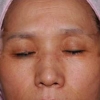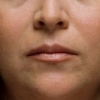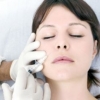L'efficacia anti-rughe dell'Argirelina
 L'Argirelina, un peptide sintetico, che è modellato dal capo N-terminale della proteina SNAP-25, riduce il grado di rughe facciali esistenti e si dimostra efficace contro il loro sviluppo. Nei nostri studi precedenti, abbiamo scoperto che l'Argirelina ha un significativo effetto antirughe nei soggetti cinesi e che è sicuro e ben tollerato.
L'Argirelina, un peptide sintetico, che è modellato dal capo N-terminale della proteina SNAP-25, riduce il grado di rughe facciali esistenti e si dimostra efficace contro il loro sviluppo. Nei nostri studi precedenti, abbiamo scoperto che l'Argirelina ha un significativo effetto antirughe nei soggetti cinesi e che è sicuro e ben tollerato.
Obiettivo: Osservare l'effetto dell'Argirelina sulle variazioni istologiche indotte dal D-galattosio, nella pelle di topi anziani.
Metodi: L'Argirelina è stata applicata su topi anziani due volte al giorno per 6 settimane. Le alterazioni istologiche nel tessuto cutaneo sono state valutate usando le colorazione ad ematossilina-eosina (HE) e il metodo polarizzazione picrosirius (PSP). Sono state anche comparate semi-quantitativamente le quantità di fibre collagene di tipo I e di tipo III utilizzando il software Image-ProPlus.
Risultati: C'è stato un miglioramento nella struttura istologica del tessuto cutaneo nei topi anziani; è aumentata la quantità di fibre collagene di tipo I (P < 0.01), mentre è diminuita quella di fibre collagene di tipo III (P < 0.05).
Conclusioni: Questo studio ha rivelato che l'Argirelina potrebbe migliorare la struttura istologica del tessuto cutaneo e ringiovanire la pelle invecchiata.
Storia della pubblicazione:
Titolo: The anti-wrinkle efficacy of Argireline
Rivista: Journal of Cosmetic and Laser Therapy. doi:10.3109/14764172.2013.769273
Autori: Yuan Wang , Mei Wang , Xiang Sheng Xiao , Jia Huo e Wei Ding Zhang
Affiliazioni: The second hospital of Xi'an Jiaotong University, Xi'an, P. R. China
Abstract:
Background: Argireline, a synthetic peptide, which is patterned from the N-terminal end of the protein SNAP-25, can both reduce the degree of existing facial wrinkles and demonstrate effectively against their development. In our past studies, we found out that Argireline had a significant anti-wrinkle effect in Chinese subjects and that it was safe and well tolerated. Objective: To observe the effect of Argireline on histological changes in the skin in the aged mice induced by D-galactose. Methods: Argireline was applied to the aged mice twice daily for 6 weeks. The histological changes in skin tissue were evaluated using hematoxylin–eosin (HE) and picrosirius–polarization (PSP) stains. The amount of type I and of type III collagen fibers were also semi-quantitatively compared using software Image-ProPlus. Results: There was an improvement in the histological structure of skin tissue in the aged mice; the amount of type I collagen fibers increased (P < 0.01), while that of type III collagen fibers decreased (P < 0.05). Conclusions: This study revealed that Argireline could improve the histological structure of skin tissue and rejuvenate the aging skin.





